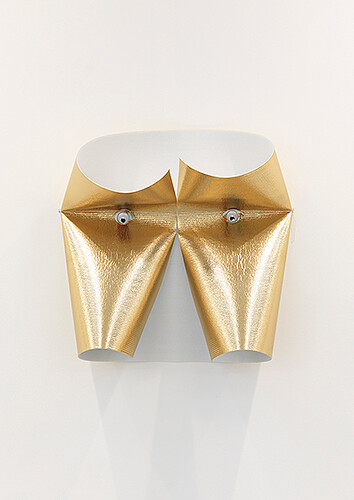Contingency and probability are long-standing conceptual interests for Mexican artist Gabriel Kuri. His 2011 exhibition at South London Gallery was titled “Before Contingency After the Fact,” for example. His current show at Sadie Coles is titled “Classical Symmetry, Historical Data, Subjective Judgement,” which, according to statistician David Spiegelhalter, are the three essential considerations for calculating the probability of an event. Still, the contingencies Kuri might be concerned with remain elusive and unspecified here, and the sculptures gathered in this show successfully convey that sense of impermanence and open-endedness.
In the room upstairs, six wall sculptures made of gilded insulating foam form a sequence of self-portraits where genre is also mutable or provisional. Some of them remind me of Hannah Wilke’s famous vaginal sculptures from the 1970s, made of chewing gum folded onto itself. Kuri’s larger and brighter sculptures, however, depart from Wilke’s feminist politics to revel in their own theatricality. In Recurring Flat Line Chart (all works 2012), for example, a plastic bag containing liquid bearing an uncanny likeness to urine hangs from what looks like the torso and upper legs of an overweight creature. In Double Self Portrait (Two Point Crossed Section Chart) that same shape becomes a face by way of two bent beverage cans placed like a pair of eyes. Despite their precarity, these shapes—like contorted yoga mats pressed to the wall by string and nails—hold dear to something unusually tantalizing. They are sensual, shiny, and full of anthropomorphic humor. Although their titles allude to typologies of charts and diagrams, what the specific subject of those diagrams might be is never mentioned or hinted at. Kuri, thus, waggishly turns the use of mathematical nomenclature into a formal fetish.
On the adjacent wall, the installation Waiting, Giving, Spent comprises six steel paper towel dispensers of different sizes and a group of giant wooden matchsticks lingering underneath them, similar to the ones he showed as part of “Shelter” (2011) at the South London Gallery. Recurring motifs are essential in Kuri’s mise en scène; like fugues in which themes re-surface when least expected. This also happens downstairs, where two metallic floor sculptures bring to mind the monochrome outdoor “ashtrays” he presented at Frieze Projects in 2010, which were soiled and thus “completed” by the cigarette stubs of the fairgoers. At Sadie Coles, what disrupts the sculptures’ immaculately lacquered metal is the chunky material of concrete. In a work called rr, a lump of cement is sandwiched between the folded angles of two blue disks, frustrating its smooth surfaces. Nearby, a pair of red and yellow overlapping circles resemble a badly finished Mastercard logo.
The last three pieces belong to a series he calls “platforms”: floor sculptures made of found panes of glass, concrete, and plywood slotted on wooden pallets and interspersed with mundane objects such as kitchen utensils. Of the three, Platforms III (bean black void) is probably the most beguiling. The bean is another symbol that Kuri has employed before, and a “bean counter” is, intriguingly enough, a fastidious type of accountant, concerned with quantification and reluctant to let go of any money. But who is the bean counter in Kuri’s work? Is he addressing those responsible for the current global financial crisis perhaps, or is it more about his own fascination with numbers and formulas?
One might think that Kuri is more comfortable with the subtlety of visual metaphors than with grand gestures and explicit statements. But it is after observing the repetition and juxtaposition of the formal and conceptual devices that punctuate his oeuvre that a political position transpires. In the thematic repertoire of the Mexican artist, the most ubiquitous concern seems to be the implication of waste. And it is precisely through this continuous investigation of consumption where Kuri’s interest in mathematics and economics makes itself most concrete. His use of everyday, cheap materials prods at the manic cycles of production, excess, waste, and recycling typical of late capitalism. In Kuri’s sculptures, clashing materials co-exist—organic and artificial, found and purpose-made—pointing to the ultimate commodification of all human resources. But this engagement with materiality is neither cynical nor blasé. It is more akin to the Mono-ha or Arte Povera movements than, say, to Pop. Crucially, despite its critical undercurrents, Kuri’s work never feels preachy, which might be the reason why one feels so compelled to linger over it, watching it unravel.






